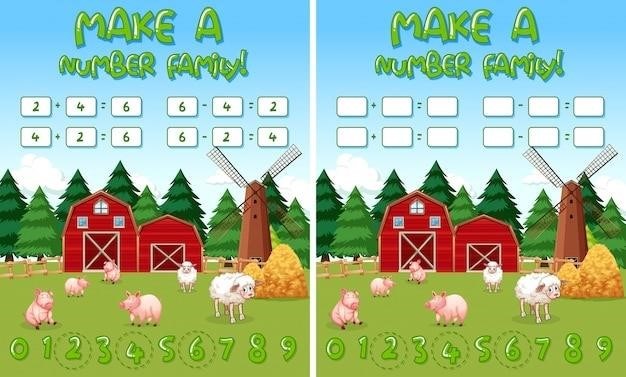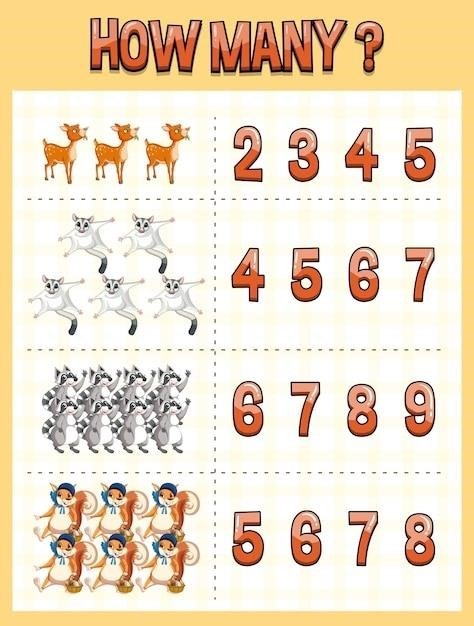Arithmetic Sequence Worksheets⁚ A Comprehensive Guide
This guide explores arithmetic sequences using worksheets. Discover how to find common differences, identify sequences, determine nth terms, and utilize explicit and recursive formulas. Practice solving word problems and calculating sums. Access free online and printable PDF worksheets, along with resources for further learning and practice problems. Improve your understanding of arithmetic sequences and their applications.
Finding the Common Difference
The common difference is the constant value separating consecutive terms in an arithmetic sequence. Finding this difference is fundamental to understanding and working with arithmetic sequences. Worksheets often begin with exercises focusing on this core concept. To find the common difference, subtract any term from the term that immediately follows it. For example, in the sequence 2, 5, 8, 11…, the common difference is 5 — 2 = 3. This process can be repeated to verify consistency; 8, 5 = 3 and 11 ⸺ 8 = 3. The common difference is crucial for determining other properties of the sequence, such as the nth term and the sum of a series. Worksheets provide ample practice in calculating the common difference from various arithmetic sequences, often involving both positive and negative values. Mastering this skill is essential for progressing to more complex problems involving arithmetic sequences. Many online resources and printable PDF worksheets offer extensive practice problems with answer keys to solidify your understanding. Practice identifying the common difference in diverse sequences is key to success in arithmetic sequence problems.
Identifying Arithmetic Sequences
Identifying arithmetic sequences is a crucial initial step in working with these mathematical patterns. An arithmetic sequence is characterized by a constant difference between consecutive terms, known as the common difference. Worksheets often present students with various number sequences, requiring them to determine whether they are arithmetic or not. This involves calculating the difference between consecutive terms and checking for consistency. If the difference remains constant throughout the sequence, it’s an arithmetic sequence. For example, the sequence 3, 7, 11, 15.;. is arithmetic because the common difference is 4 (7-3=4, 11-7=4, 15-11=4). Conversely, a sequence like 2, 4, 8, 16… is not arithmetic as the difference between terms is not constant. Worksheets frequently include mixed sequences, testing the ability to distinguish between arithmetic and other types of sequences (geometric, for instance); Practice problems focusing on identification are essential for building a solid foundation in understanding and working with arithmetic sequences, preparing students for more advanced calculations and applications. PDF worksheets with answers provide valuable self-assessment and reinforcement of this fundamental concept.
Determining the nth Term
A key skill in working with arithmetic sequences is the ability to determine the value of any term in the sequence, often represented as the “nth term.” This involves understanding and applying the explicit formula for arithmetic sequences. The explicit formula provides a direct method to calculate the nth term without needing to find all the preceding terms. This formula typically takes the form⁚ an = a1 + (n-1)d, where ‘an‘ represents the nth term, ‘a1‘ is the first term, ‘n’ is the term number, and ‘d’ is the common difference. Worksheets often present problems requiring students to use this formula. For example, given an arithmetic sequence with a first term of 5 and a common difference of 3, finding the 10th term (a10) involves substituting the values into the formula⁚ a10 = 5 + (10-1)3 = 32. These exercises build proficiency in using the explicit formula and understanding its components. Practice worksheets, especially those with answers, are invaluable for reinforcing this skill. They allow students to check their understanding and identify any areas where they need further clarification or practice, ensuring a solid grasp of the concept before moving to more complex aspects of arithmetic sequences.
Working with Explicit Formulas
Explicit formulas are fundamental to understanding and manipulating arithmetic sequences. These formulas provide a direct way to calculate any term in the sequence without having to determine all preceding terms. A typical explicit formula for an arithmetic sequence is expressed as an = a1 + (n — 1)d, where ‘an‘ represents the nth term, ‘a1‘ denotes the first term, ‘n’ signifies the term’s position, and ‘d’ stands for the common difference between consecutive terms. Worksheets often present problems that require students to use this formula to find specific terms. For instance, given an arithmetic sequence with a1 = 2 and d = 4, determining the 7th term (a7) involves substituting these values into the formula⁚ a7 = 2 + (7 — 1)4 = 26. These exercises reinforce the understanding and application of the explicit formula. Furthermore, worksheets often challenge students to derive the explicit formula themselves, given several terms of a sequence. This deeper engagement helps solidify their comprehension of the formula’s structure and its relationship to the sequence’s characteristics. The inclusion of answers in the worksheets allows for self-assessment and independent learning, enhancing the overall learning experience.
Utilizing Recursive Formulas

Recursive formulas offer an alternative approach to defining arithmetic sequences, focusing on the relationship between consecutive terms rather than the direct calculation of any specific term. A recursive formula defines a term based on its preceding term(s). In the context of arithmetic sequences, a recursive formula typically takes the form⁚ an = an-1 + d, where an represents the nth term, an-1 denotes the (n-1)th term (the term immediately preceding an), and d signifies the constant difference between consecutive terms. Worksheets incorporating recursive formulas often present problems requiring students to generate subsequent terms of a sequence, given the initial term and the common difference. For example, if a1 = 5 and d = 3, students would use the recursive formula to find a2, a3, and so on. a2 = a1 + d = 5 + 3 = 8; a3 = a2 + d = 8 + 3 = 11, and so forth. These exercises help students grasp the iterative nature of recursive definitions; Additionally, worksheets might challenge students to formulate the recursive formula themselves, given a sequence of numbers, thereby strengthening their understanding of the underlying pattern and relationship between terms. The availability of answers within the worksheet enables self-checking, fostering independent learning and problem-solving skills;
Solving Word Problems Involving Arithmetic Sequences
Applying arithmetic sequence concepts to real-world scenarios is a crucial step in solidifying understanding. Word problems on worksheets provide this practical application, transforming abstract mathematical ideas into tangible situations. These problems often involve scenarios like seating arrangements in an auditorium where each row has a consistent increase in seats, ticket sales with a daily increment, or savings plans with regular deposits. Successfully solving these problems requires students to translate the word problem’s narrative into a mathematical representation, identifying the initial term (a1), the common difference (d), and the number of terms (n). For instance, a problem might describe a stack of logs where the bottom layer has 20 logs, and each subsequent layer has 3 fewer logs than the layer below. Students would need to identify a1 = 20, d = -3, and determine the number of terms based on the problem’s context before applying the appropriate arithmetic sequence formula to find the total number of logs. The inclusion of answers within the worksheet allows students to verify their approach, identify any errors in their reasoning or calculations, and ultimately reinforce their comprehension of how arithmetic sequences model real-world situations. This iterative process of solving, checking, and learning is key to mastering the application of arithmetic sequences.
Calculating the Sum of an Arithmetic Series
Beyond understanding individual terms, arithmetic sequence worksheets often delve into calculating the sum of an arithmetic series. This involves finding the total of all terms within a specified range of the sequence. Two primary formulas are typically used⁚ one employing the first and last terms, and another utilizing the first term, the number of terms, and the common difference. Worksheets frequently present problems requiring students to determine the sum of the first ‘n’ terms, demanding a clear understanding of these formulas and their appropriate application. For example, a problem might ask for the total number of seats in a stadium with 20 rows, where the first row has 50 seats and each subsequent row increases by 5 seats. Students would initially need to identify a1 = 50, d = 5, and n = 20 before applying the summation formula to determine the total seating capacity. The inclusion of answers within the worksheet enables immediate feedback, allowing students to check their calculations and identify any misunderstandings or errors in their application of the formulas. This self-checking mechanism is vital for independent learning and reinforces the understanding of summation in arithmetic series, a fundamental concept within the broader topic of arithmetic sequences.
Advanced Problems and Applications
Advanced arithmetic sequence worksheets extend beyond basic computations, incorporating more complex scenarios and real-world applications. These problems might involve finding missing terms within a sequence given only certain terms and the common difference, or determining the common difference when only the first and last terms and the number of terms are known. Some worksheets introduce the concept of arithmetic means, requiring students to insert terms between given values to maintain a constant common difference. Real-world applications often appear in these advanced sections. Problems might involve calculating the total earnings over a period of time with a fixed salary increase each year (an arithmetic sequence), or determining the total distance traveled by an object experiencing constant acceleration (represented by an arithmetic sequence of distances covered in successive time intervals). These advanced problems encourage students to utilize their understanding of formulas and problem-solving skills within practical contexts. They challenge students to go beyond simple calculations and apply their knowledge to solve more intricate arithmetic sequence problems, bridging the gap between theoretical understanding and practical application.
Resources for Arithmetic Sequence Worksheets
Numerous resources offer arithmetic sequence worksheets with answers in PDF format, catering to various skill levels. Websites like Cuemath provide free downloadable worksheets encompassing a range of problems and concepts related to arithmetic sequences. These resources often include practice problems focusing on identifying arithmetic sequences, finding common differences, determining nth terms, and calculating sums of arithmetic series. Additionally, platforms like Teachers Pay Teachers offer a marketplace of original educational resources, including arithmetic sequence worksheets created by educators. These worksheets might include diverse problem types, such as those involving word problems, geometric interpretations, or applications to real-world scenarios. The Internet Archive offers a substantial collection of digital content, including potentially relevant books and articles on arithmetic sequences. Free-eBooks might offer additional resources, while educational websites and platforms frequently provide interactive exercises and tutorials, supplementing the practice provided by downloadable worksheets. The availability of diverse resources ensures that students can find materials that align with their specific learning needs and preferences, fostering a comprehensive understanding of arithmetic sequences.
Free Online Worksheets
The internet offers a wealth of free online arithmetic sequence worksheets with answers in PDF format. These resources are readily accessible and provide convenient practice materials for students. Many educational websites and platforms offer free worksheets covering various aspects of arithmetic sequences, including finding the common difference, determining the nth term, and calculating the sum of an arithmetic series. These online worksheets often feature a variety of problem types, ranging from basic exercises to more challenging problems involving word problems or real-world applications. Some websites allow users to customize worksheets, selecting the number of problems, difficulty level, and types of questions included. This flexibility enables teachers and students to tailor their practice to specific learning needs and goals. The availability of free online worksheets makes it easy to access high-quality practice materials without any cost, supporting effective learning and skill development in arithmetic sequences. Remember to check the reliability and accuracy of the provided answers before using any online resource.
Printable PDF Worksheets

Printable PDF worksheets offer a tangible and readily available resource for practicing arithmetic sequences. These downloadable worksheets provide a structured format for practicing various concepts related to arithmetic sequences, including finding the common difference, determining the nth term, and solving word problems. The convenience of printable PDFs allows for offline access, making them ideal for classrooms or individual study settings where internet connectivity might be limited. Many websites offer free printable arithmetic sequence worksheets with answers, making them a cost-effective solution for students and educators alike. These worksheets often include a diverse range of problems, catering to different skill levels and learning objectives. The ability to print multiple copies ensures that each student can have their own worksheet to complete, facilitating independent practice and reducing the need for shared resources. The inclusion of answers allows students to self-check their work and identify areas needing further attention, promoting independent learning and self-assessment. Moreover, the visual nature of printed worksheets can enhance engagement and comprehension for some learners.
Educational Websites and Platforms
Numerous educational websites and platforms provide valuable resources for learning about and practicing arithmetic sequences. These online resources often offer interactive exercises, tutorials, and printable worksheets, catering to diverse learning styles and preferences. Websites like Khan Academy, for instance, provide comprehensive lessons on arithmetic sequences, accompanied by practice problems with detailed solutions. These platforms often incorporate multimedia elements like videos and animations to enhance understanding and engagement. Interactive exercises allow students to receive immediate feedback on their answers, promoting self-correction and reinforcing learning. Furthermore, many educational websites offer a wide range of difficulty levels, ensuring that students of all abilities can find appropriate challenges. The accessibility of these online resources makes them a valuable supplement to traditional classroom learning, offering students the flexibility to learn at their own pace and revisit concepts as needed. Access to these platforms can bridge learning gaps and provide additional support outside of formal instruction. The use of educational websites and platforms can greatly enhance the learning experience for students working with arithmetic sequences.
Different Types of Problems in Worksheets
Arithmetic sequence worksheets encompass a variety of problem types designed to build a comprehensive understanding. These problems range from basic identification of arithmetic sequences and calculating common differences to more complex applications. Worksheets often include exercises requiring students to find specific terms within a sequence, using both explicit and recursive formulas. Identifying missing terms in a sequence is another common problem type, testing the student’s grasp of the underlying patterns. Word problems present real-world scenarios that require students to translate verbal descriptions into arithmetic sequences and then solve for unknowns. These can involve applications such as calculating the total number of seats in a stadium with a specific pattern or determining the amount of money saved over time based on a constant savings rate. Some worksheets also delve into finding the sum of arithmetic series, which builds upon the understanding of individual terms and the properties of arithmetic sequences. The inclusion of diverse problem types helps solidify understanding and prepare students to apply their knowledge to a variety of contexts. Advanced worksheets might incorporate problems involving geometric-arithmetic sequences or sequences with varying patterns. This variety ensures a well-rounded understanding of arithmetic sequences.
Practice Problems and Examples
To effectively grasp the concepts of arithmetic sequences, ample practice is crucial. Worksheets provide a structured platform for this practice, offering a range of problems of varying difficulty. Simple problems might involve identifying whether a given sequence is arithmetic and determining the common difference. More challenging problems could require finding a specific term in a sequence using the explicit formula, or constructing a recursive formula given the first term and common difference. Word problems add another layer of complexity, requiring students to translate real-world scenarios into mathematical representations. For instance, a problem might involve calculating the total number of seats in a stadium based on a pattern or determining the total savings after a certain number of months with a constant monthly deposit. Examples within the worksheets often guide students through the solution process, demonstrating the application of formulas and problem-solving strategies. These examples serve as templates for tackling similar problems independently. The inclusion of answers allows students to self-check their work, reinforcing correct understanding and identifying areas needing further attention. This iterative process of practice, example review, and self-assessment is key to mastering arithmetic sequences.


